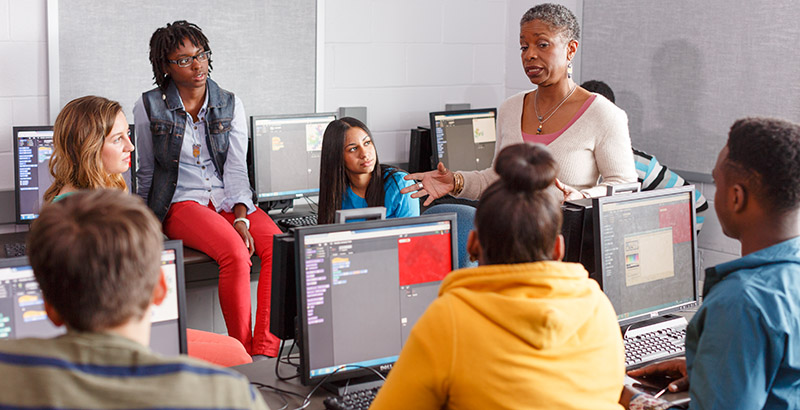Hands-On AP Computer Science Principles Course Has Broad Appeal for Diverse Groups of Students — and Is Changing How They See Themselves

Seth Reichelson has been teaching Advanced Placement Computer Science Principles at Lake Brantley High School in Orlando, Florida, for three years, and he’s still surprised by the ingenuity the course brings out in his students. “I love seeing what my students design and implement,” he says of the nation’s fastest-growing AP class.
Introduced three years ago, AP Computer Science Principles takes a much more creative, hands-on approach than the AP’s old standby, Computer Science A — with the goal of appealing to a far more diverse array of students. Just take a look at the AP’s descriptions of the two courses:
AP Computer Science A: “The design and implementation of computer programs to solve problems involve skills that are fundamental to the study of computer science. This includes the development and analysis of algorithms and fundamental data structures, and the use of logic and formal methods.”
AP Computer Science Principles: “Computer science is everywhere, from our smartphones and video games to music, medicine and much more. AP Computer Science Principles can help you understand how computing and technology influence the world around you. Learn how to creatively address real-world issues while using the same tools and processes that artists, writers, computer scientists and engineers use to bring ideas to life.”
Students learn everything they would in a programming class, but also gain a deeper knowledge of the computing world, says Reichelson. “For example,” he adds, “they look behind the scenes of applications they use almost every hour of their lives.”
That appeal seems to be catching on.
The number of schools offering the course has jumped from about 2,500 in 2016 to 3,700 in 2017, and more than 76,000 students took the end-of-course exam last May, up from 50,000 in May 2017. But perhaps more important, the College Board, which administers the AP program, credits the curriculum with increasing participation in the Computer Science Principles exam by 70 percent among African-American students, 61 percent among Hispanic students, and 70 percent among female students.
Much of this diversification comes from the content. With AP Computer Science A, “We were attracting students who already knew they wanted to pursue this path,” says Executive Director Maureen Reyes. “But for students who didn’t know if computer science was for them, it wasn’t attracting them. What was going to engage students was a broad introduction, the principles behind computer science. What are the big ideas? How does the internet work? What is the creative aspect, the global impact of computing?”
Crystal Furman, director of AP instruction, design and professional development, says College Board staff spent years developing the curriculum to make the new course as successful as possible — and as straightforward for teachers who might not have a strong computer science background.
“CSP is a breadth course, exposing students to all the different related fields: the internet, data analysis, the impact of the computer globally,” Furman says. “The students are gaining a lot of skills in terms of understanding practices, how you write programs, how you use the internet, along with computing devices and how you make things work.”
Reichelson says the content differs from that of any other AP course he has seen, requiring a different mindset for teachers. “The content and tone of this class is significantly better,” he says. “However, if you teach the class the same way as the old AP Computer Science class, I don’t see the [participation] numbers going up naturally.”
But, he says, a “talented teacher with this content is a tornado.”
Some educators may need to embrace a more collaborative approach and let students, at times, take the lead. “Teachers who have been teaching for many, many years tell us this is their favorite class to teach,” Reyes says. “They are learning with the students. There is this mentality and energy in the classroom that we are all working together and solving the problem together.”
Adds Reyes, “We have had a number of students say the hands-on approach to this really drew them in.”
Students can choose a project that becomes part of their final grade, along with the end-of-course exam and two class tasks uploaded throughout the year. One task requires students to build a program in whatever language they like — devising an app to address a need in the community, perhaps, or creating an adventure story — while the other involves researching and exploring any computing innovation that catches their eye.
“We are seeing all kinds of submissions, and really what the students are interested in,” Reyes says. “It is what keeps them, quite honestly, interested in the class.”
Adds Furman, “They are able to solve problems and they are proud of that … taking it home and showing their families what they were able to do.”
Attracting a new population of students, Reyes says, has opened up AP as an option to kids who wouldn’t have otherwise considered trying an advanced class. “Now they see themselves as an AP student,” she says. “We really wanted to make a course all students could see themselves in and spark that interest.”
Ralph Morelli, principal investigator with Mobile CSP Project, a College Board-endorsed AP Computer Science Principles curriculum, says students are building mobile apps that work in the real world while learning about computer science principles that they can apply to their apps. “What teachers say is that they’ve never seen students so engaged and that it exceeds their expectations,” he says.
The business community has taken notice too. For the past two years, Facebook has brought 100 CSP teachers to California for an opportunity to hear from professionals in the field. “Most of their students don’t know anybody who works in a big tech company,” Reyes says. “We wanted to help the teachers understand what that might be like and give them that exposure to bring back to the students.”
The Chan Zuckerberg Initiative has joined the AP effort financially, supporting College Board’s work specifically in Kentucky and Nevada.
April Chou, interim head of education for CZI, says the organization seeks to present underrepresented students with opportunities that can help them thrive in their future endeavors. “We are inspired by the emerging results of our partnership with the College Board in their efforts to dramatically expand access to advanced computer science education for young people, particularly students traditionally underrepresented in STEM fields” — science, technology, engineering and math, she says.
Just one school year into the partnership, Chou says she has seen the efforts nearly triple the number of girls and Hispanic students taking AP CSP in Nevada, giving STEM access to an entire group of students who now not only have a fresh employment path to consider but also the skills to take that path if they choose.
“We have,” as Reichelson says, “momentum and the class we have been waiting for.”
Disclosure: The Chan Zuckerberg Initiative provides financial support to The 74.
Get stories like these delivered straight to your inbox. Sign up for The 74 Newsletter

;)
